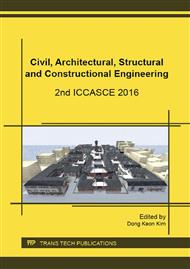p.50
p.57
p.61
p.67
p.73
p.81
p.86
p.91
p.98
Analysis of Unstable Rock-Mass Stability Based on Limit Equilibrium Method and Strength Reduction Method
Abstract:
With the slope unstable rock masses of a stope in Longsi mine, Jiaozuo City, China as the target, we computed and analyzed the stability of unstable rock masses using a limit equilibrium method (LEM) and a discrete element strength reduction method (SRM). Results show that the unstable rock masses are currently stable. Under the external actions of natural weathering, rainfall and earthquake, unstable rock mass 1 was manifested as a shear slip failure mode, and its stability was controlled jointly by bedding-plane and posterior-margin steep inclined joints. In comparison, unstable rock mass 2 was manifested as a tensile-crack toppling failure mode, and its stability was controlled by the perforation of posterior-margin joints. From the results of the 2 methods we find the safety factor determined from SRM is larger, but not significantly, than that from LEM, and SRM can simulate the progressive failure process of unstable rock masses. SRM also provides information about forces and deformation (e.g. stress-strain, and displacement) and more efficiently visualizes the parts at the slope that are susceptible to instability, suggesting SRM can be used as a supplementation of LEM.
Info:
Periodical:
Pages:
73-80
Citation:
Online since:
November 2016
Authors:
Price:
Сopyright:
© 2017 Trans Tech Publications Ltd. All Rights Reserved
Share:
Citation:


